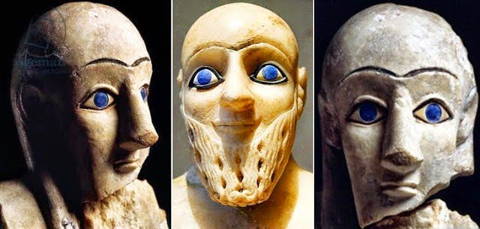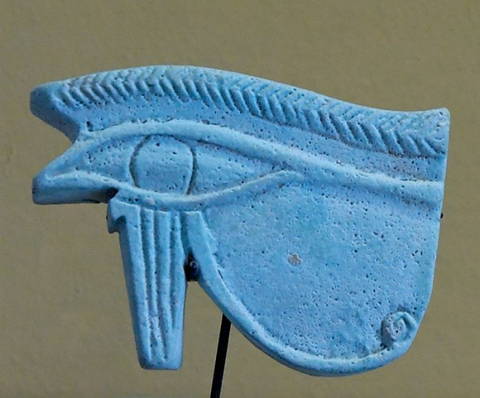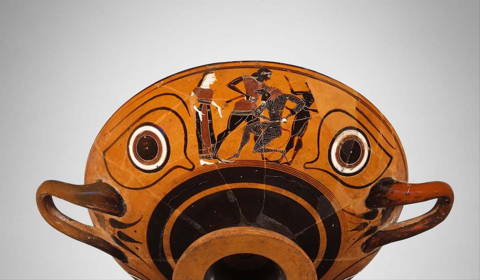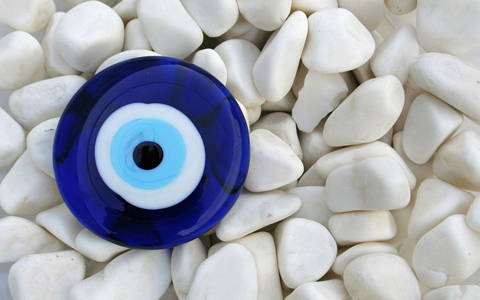Mesopotamia
The first mentions of the evil eye occurred 3000BC in Mesopotamia, where the Sumerians believed the eyes of their Gods, supernatural beings, animals and humans could cause illness, death, and damage on a large scale. However researches how not found specific mentions of the malefic gaze of the evil eye in their literature. The Sumerians believed the crystal Lapis Lazuli could ward of the evil eye, they included Lapis Lazuli in their statues of their GodsTheir version of the evil eye could be associated with witchcraft and spells although it's not limited to witchcraft alone. It was a central belief system of the ancient Sumerian culture that is widely reflected in their literature.

Mesopotamian statues featuring blue eyes made out of Lapis Lazuli crystals. source: ancientpages.com
Ancient Egypt
Egypt also has a history with evil eye beliefs and charms, dating back to 15th Century BC. The early sun god was named Horus but he was not just associated with the sun. His two eyes were said to be both the sun and the moon. When Ra took over the title of sun god, he was also known as “Ra-Horakhty or Ra, who is Horus of the 2 horizons.”
It was in a battle with Set that Horus lost the use of one eye. It is often debated which one as two myths do not agree with each other on which eye was damaged. Because many ancient Egyptians believed that the Eye was all-seeing, they decided that the best use for it was to bring the eye to jewelry, amulets, knives, and other items in their daily life. By doing so, the ancient Egyptians and Palestinians thought they were being protected from evil.

Eye of Horus, Achaemenid artwork, late 6th–4th centuries BC. From the Tell of the Apadana in Susa. Credit: Marie-Lan Nguyen
Ancient Greece, Rome and Assyria
The first charms to protect against the evil eye (not the Eye of Horus) appeared in the 6th century BC on Chalcidian drinking vessels, known as 'eye cups', as a type of apotropaic magic. Many ancient Greek philosophers like Plutarch and Plato believed that receiving the evil eye will cause misfortune or injury and even death. The ancient Greeks also believed some people were more skilled at giving the evil eye than others. They believed people with blue eyes had the power to give the evil eye. Talismans or amulets were created to protect against the evil eye are also frequently called "evil eyes", which were also blue colored. The belief in the evil eye spread when Alexander the Great took the Greek culture to the east.

Chalcidian Eye Cup, 530B.C. , Metropolitan Museum of Art

Glass Evil Eye bead
Evil Eye in religions
Although the evil eye is not part of any particular religion as it is more of a spiritual belief, it has been mentioned in multiple religions.
In Islam the evil eye (al-’ayn) is a common belief that individuals have the power to look at people, animals or objects to cause them harm. It is tradition among many Muslims that if a compliment is to be made one should say "TabarakAllah"("Blessings of God") or "Masha'Allah" ("God has willed it") to ward off the evil eye. Scholars have a difference of opinion whether talismans using the Quran is permissible or not.
In Judaism the evil eye is mentioned several times in the classic Pirkei Avot. A man with "an evil eye" will not only feel no joy but experience actual distress when others prosper and will rejoice when others suffer. A person of this character represents a great danger to our moral purity, according to some Jews.
In Hinduism, the evil eye is known as Kudrishti or Karikannu. There appear to be no references to evil eye in Hindu scriptures. The literature on the concept is limited, mainly confined to casual references to real life incidents. But the concept is well known and is accepted throughout India among all communities of Hindus. The prayers, methods and rituals adopted to counter evil eye vary from region to region and from community to community.
In Christianity, the Old Testament of the Bible refers to the evil eye in Proverbs 23:6, cautioning, “Eat thou not the bread of him that hath an evil eye, neither desire thou his dainty meats.” It has been debated wether the Bible is actually referring to the evil eye or wether it has been wrongly translated from the Greek version of the Bible.
Evil Eye in today's society
Today the belief in malevolent glares is still as present as it was years ago, maybe even more? Many of us are going through a spiritual awakening, paying attention to our energy and those of others around us, doing what we can to preserve a positive essence. We are cleansing our spaces, meditating, using crystals and lucky charms and protective charms. It is beautiful to see such an ancient belief be so alive today!

Evil Eye jewelry displayed in todays fashion

